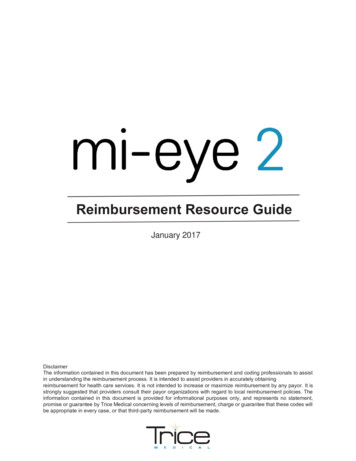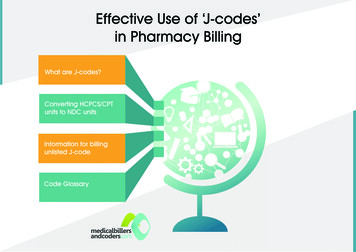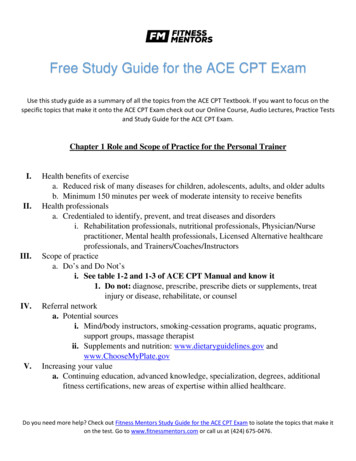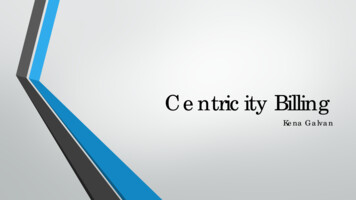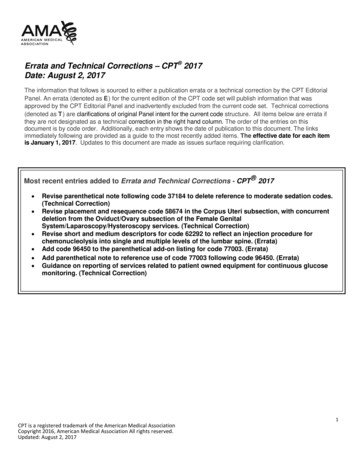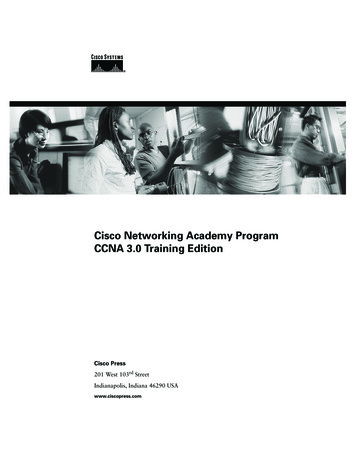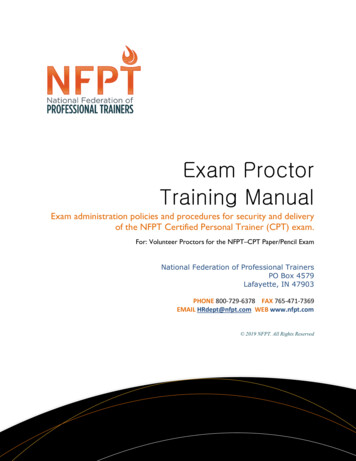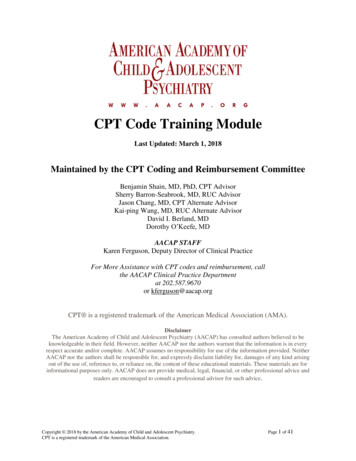
Transcription
CPT Code Training ModuleLast Updated: March 1, 2018Maintained by the CPT Coding and Reimbursement CommitteeBenjamin Shain, MD, PhD, CPT AdvisorSherry Barron-Seabrook, MD, RUC AdvisorJason Chang, MD, CPT Alternate AdvisorKai-ping Wang, MD, RUC Alternate AdvisorDavid I. Berland, MDDorothy O’Keefe, MDAACAP STAFFKaren Ferguson, Deputy Director of Clinical PracticeFor More Assistance with CPT codes and reimbursement, callthe AACAP Clinical Practice Departmentat 202.587.9670or kferguson@aacap.orgCPT is a registered trademark of the American Medical Association (AMA).DisclaimerThe American Academy of Child and Adolescent Psychiatry (AACAP) has consulted authors believed to beknowledgeable in their field. However, neither AACAP nor the authors warrant that the information is in everyrespect accurate and/or complete. AACAP assumes no responsibility for use of the information provided. NeitherAACAP nor the authors shall be responsible for, and expressly disclaim liability for, damages of any kind arisingout of the use of, reference to, or reliance on, the content of these educational materials. These materials are forinformational purposes only. AACAP does not provide medical, legal, financial, or other professional advice andreaders are encouraged to consult a professional advisor for such advice .Copyright 2018 by the American Academy of Child and Adolescent Psychiatry.CPT is a registered trademark of the American Medical Association.Page 1 of 41
CPT Training ModuleTable of ContentsIntroduction .3Three Components of Relative Value Units (RVUs) .3Fraud and Abuse .4CPT Codes for Child and Adolescent Psychiatrists .6 Evaluation and Management Services (99xxx) .6 Psychiatric Diagnostic Codes .9 Psychotherapy Codes .10 Interactive Complexity.12 Other Psychotherapy .13 Other Psychiatric Services .14 Care Coordination / Collaborative Care Codes .16 Other Codes .22o Screening Codes.23o Prolonged Services.25o Telephone Services .27 Modifiers .29Common Psychiatric Code Summary .30AppendicesA. Partial Glossary .31B. E/M Coding Summary Guide .32C. Sustainable Growth Rate and Congress .33D. Code Categories .34E. Social History of American Medicine .35References .40Copyright 2018 by the American Academy of Child and Adolescent Psychiatry.CPT is a registered trademark of the American Medical Association.Page 2 of 41
CPT TRAINING MODULE FOR CHILD AND ADOLESCENTPSYCHIATRISTSINTRODUCTIONCurrent Procedural Terminology (CPT) codes describe medical procedures and services providedby physicians and other qualified healthcare professionals (QHP). The American MedicalAssociation (AMA) owns and maintains CPT codes. The Healthcare Insurance Portability andAccountability Act (HIPAA) of 1996 included electronic billing standards requiring CPT codesto report physician services.The Center for Medicare and Medicaid Services (CMS) uses a physician payment system knownas the Resource Based Relative Value Scale (RBRVS) to assign each CPT code a Relative ValueUnit (RVU). The Relative Value Scale Update Committee (RUC) - sponsored and maintained bythe AMA - recommends RVU values to CMS. CMS publishes the RVU value in the Final Ruleof the Federal Register every November. Congress mandates reviewing these values every fiveyears.This module explains: The RVU determination process for CPT codes, consequences of failing to utilize correct coding (fraud and abuse), CPT codes from the psychiatry section of the current CPT manual, and Evaluation and Management codes.Appendix A is a glossary of commonly used terms; Appendix B discusses the Conversion Factorand Sustainable Growth in Healthcare; Appendix C discusses CPT code categories: Category 2(tracking) and Category 3 (emerging technology/services) codes. Appendix D presents the Meritbased Incentive Payment System (MIPS) from the Patient Protection and Affordable Care Act(ACA) 2010.Relative-Value Scale Update Committee (RUC)Relative Value Units (see next section) are assigned to CPT codes by CMS after receivingrecommendations from the RUC. The RUC consists of 31 voting members representing thelargest medical societies in the AMA House of Delegates. Advisers serve from the remainder ofthe medical societies in the House of Delegates. The American Psychiatric Association has avoting member and the American Academy of Child & Adolescent Psychiatry has an advisor,currently Dr. Sherry Barron-Seabrook.THREE COMPONENTS OF RELATIVE VALUE UNITS (RVUs)Three components determine the resource cost of providing a service: physician work practice expense professional liability insurance expenseCopyright 2018 by the American Academy of Child and Adolescent Psychiatry.CPT is a registered trademark of the American Medical Association.Page 3 of 41
Physician Work (Relative Value Work or RVW)The physician work component accounts for an average of 51% of the total relative value foreach service. The factors used to determine physician work include: amount of time to perform the service/procedure plus pre- and post-service time technical skill and physical effort involved in performing the service/procedure mental effort and judgment required stress due to potential risk to the patient from the underlying illness or procedurePractice Expense (PE)Practice expense RVUs account for an average of 45% of the total value for each service. ThesePE values reflect office costs like play equipment, rent, utilities, billing expenses, etc. Since2004, all new or revised codes presented to the RUC must include both work and PE values.Professional Liability Insurance (PLI)The professional liability insurance component accounts for an average of 4% of the total;relative value for each service.Conversion FactorThe sum of these 3 components (work units practice expense units professional liabilityexpense units) yields the RVU. The RVU is then multiplied by a conversion factor (a monetaryfigure determined by CMS) and adjusted for geographical variability to arrive at the payment.For example: for 99213, RVW is 0.97, PE for non-facility is 1.02, PLI is .07; therefore, 0.97 1.02 .07 2.06 (Total RVU). That number is multiplied by 35.99 (the Conversion Factor for2018) to arrive at the Medicare payment of 74.14 (before the geographic factor is applied) for99213. (Go to arch/search-criteria.aspx forthe complete list of CPT codes and their RVUs.)Scope of CPT And RUCWhile the Healthcare Insurance Portability and Accountability Act of 1996 (HIPAA) mandatesthat private payers use current CPT codes, CPT code reimbursement values are applicable onlyto services billed to Medicare through any of its regional carriers. Private payers may set theirown reimbursement values.FRAUD AND ABUSEThe only legal way to be paid for a service is to bill using the correct CPT code. You mustdocument that the level of service claimed was medically necessary and delivered.Kennedy-Kassebaum (Title II of HIPAA, 1996): Added “knowingly and willingly” standard to false claims legislation. Before 1996,physicians could be accused of violating the law if they simply made a mistake. Now, thestandard is “knowingly and willingly,” BUT ignorance of coding rules is NOT anacceptable explanation for repeated coding errors.Made “falsifying” a private claim a federal offense like falsifying a Medicare/Medicaidclaim.Added 700 investigators to the Inspector General’s office at CMS.Copyright 2018 by the American Academy of Child and Adolescent Psychiatry.CPT is a registered trademark of the American Medical Association.Page 4 of 41
The physician is responsible (and liable) for all coding done in that physician’s name.The physician is responsible for appropriate documentation of services even if the patientor physician’s employer submits the bill to an insurance company.False ClaimsBilling for services not provided (False Claims Act (FCA) 1986).Up codingReporting a higher-level service or procedure than one that is performedor is medically necessary (eg, Reporting the psychotherapy add on codefor less than 16 minutes of psychotherapy. Coding 99214 whiledocumentation and medical necessity support a lower level of service).Code editsBilling codes that do not belong together (Correct Coding Initiative – CCI)(eg, Violating AdminiStar software program – most edits involve surgicalprocedures like separate billing for amputation of digits and foot whenperforming a below the knee amputation). Edits for the current psychiatrycodes are being efault.asp)).Medically Unlikely Edits (MUE)Codes that are unlikely to be billed together. These edits may be appealedon a case-by-case basis. (eg, multiple psychotherapy sessions for the samepatient on the same day). Originally, the edits were called “medicallyunbelievable,” but because of physician objection, the term “unlikely” wassubstituted for “unbelievable,” maintaining the acronym MUE. MUEs forthe current psychiatry code set continue to be developed.Consequences: Damages up to 3 times the amount of the claim. Mandatory penalties of 5,000 to 10,000 per claim, regardless of the size of the claim. The Return-on-Investment (ROI) is about 8 for every 1 spent in the investigation.Funds are transferred to the Medicare Trust Funds ( 2.5 B in FY 2012). Some of thesemonies are used to support the salary of the investigators. See 2.pdf (HCFAC Healthcare Fraudand Abuse Control). Whistle-blowers act in the name of the government and may seek the same damages. TheDepartment of Justice may intercede, and the whistle-blower could still receive 15% to25% of the claim. The whistle-blower may proceed alone and keep up to 30% of the finalrecovery. Such cases are also called “qui tam” cases.Code CategoriesThe Health Insurance Portability and Accountability Act (HIPAA) required CMS to requestproposals for alternative coding systems. The AMA initiated the CPT 5 project to developnecessary modifications. In August 2000, CMS announced that it would continue to use CPT asthe coding system for medical procedures for Medicare patients. Two additional code categories(II and III) debuted in CPT 2002 and are discussed in Appendix C.Copyright 2018 by the American Academy of Child and Adolescent Psychiatry.CPT is a registered trademark of the American Medical Association.Page 5 of 41
CPT CODES FOR CHILD AND ADOLESCENT PSYCHIATRISTSCPT 2013 redesigned the structure of the commonly used psychiatric codes. From 1997 through2012, psychiatric CPT codes were divided into “diagnostic or evaluation interview procedures”and “psychiatric therapeutic procedures” (and further sub-divided into office vs facilitypsychotherapy; other psychotherapy and other psychiatric procedures). HIPAA (1996) andMental Health Parity and Addiction Equality Act of 2008 (MPHAEA) require providers to useCPT in all electronic claims for psychiatric services to all insurance companies, both private andgovernment sponsored. Psychiatrists use CPT Codes to report these services: Evaluation and Management (E/M) ServicesPsychiatric diagnostic evaluationPsychotherapyInteractive complexityOther psychotherapyOther psychiatric servicesCollaborative care servicesOther codesModifiersEvaluation and Management (E/M) CodesHistoryCPT (2013) deleted 90862 (pharmacologic management) with instructions to use E/M codes toreport these services. The availability of E/M codes to psychiatrists allows psychiatric services tobe reported with the same range of complexity and physician work as all other medicalspecialties.While Medicare always allowed psychiatrists to use E/M codes, until 2010 few private payersreimbursed psychiatrists for E/M codes for outpatient services. Psychiatrists were essentiallyrestricted to the use of the basic “one size fits all” 90862 code for pharmacologic management.Code 90862 poorly described the complexity of current psychiatric practice and accounted for60% of psychiatrist billing. This code, written when the standard for pharmacologic managementwas prescribing one or occasionally two psychotropic medications at a time had becomeoutdated. Revisions were needed to address the increased complexities of psychopharmacologicmanagement in current practice. E/M codes best describe the work and medical decision makingnow required.E/M codes may report evaluation and management services either alone (pharmacological/medical management and no other service reported that day) or with the addition ofpsychotherapy. Psychotherapy is reported as an “add-on” code to the primary procedure, the E/Mservice. This change effectively reverses “psychotherapy with or without E/M” to “E/M with orwithout psychotherapy.” The parameters of psychotherapy, such as time, presence of interactivecomplexity, and site of service, are discussed below. For additional information, go to theAACAP website, and click on CPT and Reimbursement under Member Resources at the top ofthe homepage. There are webinars for specific, detailed information on the 2013 codes as well asselecting and documenting E/M codes.Copyright 2018 by the American Academy of Child and Adolescent Psychiatry.CPT is a registered trademark of the American Medical Association.Page 6 of 41
Common Evaluation and Management Code Families Used by PsychiatristsE/M DescriptionCodesOffice or Other Outpatient Services, new patient99201 to 99205Office or Other Outpatient Services, established patient99211 to 99215Office or Other Outpatient Consultations, new or established patient99241 to 99245Initial Hospital Care, new or established patient99221 to 99223Subsequent Hospital Care, new or established patient99231 to 99233Inpatient Consultations99251 to 99255Other E/M code families include observation care (99218 to 99220, 99224 to 99226),observation or inpatient care services (99234 to 99236), nursing facility care (99304 to 99306,99307 to 99310), emergency department services (99281 to 99285), domiciliary, rest home, orcustodial care services (99324 to 99328, 99334 to 99337), home services (99341 to 99345,99347 to 99350), and neonatal and pediatric critical/intensive care (99468, 99469, 99471, 99472,99475, 99476, 99291, 99292, 99477 to 99480). As most psychiatrists will be using Office orOther Outpatient Services, Established Patient (99211 to 99215), this section will use this codefamily as examples. First, however, one must distinguish a “new” from “established” patient touse CPT correctly.What is a “new” patient?Using new patient E/M codes (99201 to 99205) is more restrictive than using psychiatricdiagnostic evaluation codes (90791, 90792; described in the following section.). New patientsmust not have received any professional services in the past three years by the physician ORanother physician in the same group practice of the exact same specialty and sub-specialty.Advanced practice nurses, physician assistants and covering professionals working withphysicians are considered as working in the exact same specialty and exact same subspecialtiesas the physician.Determining Evaluation and Management Levels by TimeTime or key components determines the level of E/M codes in both outpatient or inpatientsettings. Time is a simpler criterion and requires that counseling and/or coordination of careaccounts for more than 50% of the encounter. Time for office and outpatient visits is only theface-to-face time with the patient and/or family members. Inpatient or hospital consultation timeis unit floor time and consists of patient and/or family contact, chart review, orders, writingnotes, telephone calls, and meeting with the treatment team while on the “floor.”Copyright 2018 by the American Academy of Child and Adolescent Psychiatry.CPT is a registered trademark of the American Medical Association.Page 7 of 41
Counseling is discussion with patient and/or family about diagnostic results, prognosis, treatmentrisks and benefits, risk factor reduction, treatment compliance, and/or education. Coordination ofcare is discussion of patient care with other providers or agencies.Codes and “Typical” TimeDescriptionOffice or Other OutpatientServices, new patient9920110 min9920220 min9920330 min9920445 min9920560 minOffice or Other OutpatientServices, established patient992115 min9921210 min9921315 min9921425 min9921540 minOffice or Other OutpatientConsultations, new orestablished patient9924115 min9924230 min9924340 min9924460 min9924580 minInpatient Consultations9925120 min9925240 min9925355 min9925480 min99255110 minDetermining Evaluation and Management Levels by Key ComponentsRather than using time to select the level of E/M code, physicians may use key components.Please see the video webinars under the dropdown Menu (CPT) on the Member Resource tab onthe AACAP homepage as well as carefully review the AMA’s CPT Manual for a fullunderstanding.The three key components are history, examination, and complexity of medical decision making.Established patients for office or other outpatient services (99211 to 99215) only require 2 out of3 key components. “New” patients (as defined above) require 3 out of 3 key components (99201to 99205). Each key component has four levels.See Appendix A with E/M Coding Summary Guide v2.(http://www.aacap.org/App Themes/AACAP/docs/clinical practice center/business of practice/cpt/EM Coding Summary Guide v2.pdf)History consists of four levels – problem focused, expanded problem focused, detailed, andcomprehensive depending on the amount of information from the history of present illness (HPI),past, family, social history (PFSH), and review of systems (RoS).Examination consists of four levels - problem focused, expanded problem focused, detailed, andcomprehensive depending on the number of elements. In 1997, for CPT purposes, HCFA (nowCMS) recognized 10 single organ systems whose examination could be documented in place ofthe general multi-system examination to meet standards for the levels of E/M codes. Psychiatryis recognized as having a single organ system examination and includes mental status,constitutional and musculoskeletal elements.Medical decision making consists of four levels – straightforward, low complexity, moderatecomplexity and high complexity. The calculation of complexity depends on diagnosis,management options, data reviewed (eg, records, labs, test results), and level of risk (eg,Copyright 2018 by the American Academy of Child and Adolescent Psychiatry.CPT is a registered trademark of the American Medical Association.Page 8 of 41
potential complications, morbidity). Please review the AMA CPT manual and the AACAPwebinars for a better understanding of this calculation.See the table of risk on page 16 of the E/M services guide: mgmt-serv-guideICN006764.pdf) or in the Summary Guide (https://www.aacap.org/App Themes/AACAP/docs/clinical practice center/business of practice/cpt/EM Coding Summary Guide v2.pdf)Psychiatric Diagnostic EvaluationPsychiatric Diagnostic Evaluation without medical services (90791)The evaluation may include communicating with family or other sources, as well as reviewingand ordering non-medical diagnostic studies.Psychiatric Diagnostic Evaluation with medical services (90792)As above (90791), the evaluation may include communicating with family or other sources, aswell as reviewing and ordering diagnostic studies. It must include medical services. “Medicalservices” refers to “medical thinking” as well as medical activities (eg, physical examination,prescription of medication, and review and ordering of medical diagnostic tests). Medicalthinking must be documented (eg, consideration of a differential diagnosis, medication change,change in dose of medication, drug-drug interactions).For both 90791 and 90792: In certain circumstances one or more other informants (family members, guardians, orsignificant others) may be seen in lieu of the patient. Both codes may be reported more than once for the patient when separate diagnosticevaluations are conducted with the patient and other informants on different days. Use the same codes, for later reassessment, as indicated. Do not report on the same day as psychotherapy or an E/M service. If present, the interactive complexity component of the diagnostic evaluation is capturedby reporting the interactive complexity add-on code 90785 in conjunction with 90791 or90792.Do not report with 90839, 90840, 0364T, 0365T, 0366T, 0367T, 0373T, 0374TDo not report with 99201, 99337, 99341-99350, 99366-99368, 99401-99444, 0368T, 0369T,370T, 0371TPsychotherapyCPT 2017 removed the words “and/or family” from psychotherapy codes (90832, 90833, 90834,90836, 90838, 90839). These are considered individual psychotherapy codes focused on thepatient. While family member(s) may participate, the patient must be present for all, or theCopyright 2018 by the American Academy of Child and Adolescent Psychiatry.CPT is a registered trademark of the American Medical Association.Page 9 of 41
majority of the service. As long as the patient is present for a majority of the service,psychotherapy time spent with family member(s) or other informant(s) when the patient is notpresent counts toward the time requirement for selecting the code.Psychotherapy codes that specify a specific time follow the CPT 2011 time rule (i.e., aunit of time may be billed when the mid-point of time interval is passed), as listed below.Psychotherapy, 30 minutes (90832)Psychotherapy, 45 minutes (90834)Psychotherapy, 60 minutes (90837)Psychotherapy, 30 minutes, with E/M service (90833)Psychotherapy, 45 minutes, with E/M service (90836)Psychotherapy, 60 minutes, with E/M service (90838)Used when coding psychotherapy conducted on the same day as an E/M service.Time determines the selection of the appropriate psychotherapy code: 16-37 minutes for 90832or 90833; 38-52 minutes for 90834 or 90836; 53-89 minutes for 90837 or 90838. Psychotherapymust be at least 16 minutes to be reported. For psychotherapy of 90 minutes, use 90837 and theappropriate prolonged service code (99354-99357).Since 2013, the psychotherapy add-on codes allow psychiatrists to report psychotherapywith the full range of E/M codes. To report both E/M and psychotherapy, the two services mustbe significant and separately identifiable. However, the time within the service does not have tobe distinctly separated (i.e. elements of psychotherapy may be interwoven with evaluation/management elements). CPT gives a roadmap for separately identifying the medical andpsychotherapeutic components of the service:1. The type and level of E/M service is selected first based upon the key components of history,examination, and medical decision-making.2. Time associated with activities used to meet criteria for the E/M service is not included in thetime used for reporting the psychotherapy service (i.e., time spent on history, examination, andmedical decision making when used for the E/M service is not psychotherapy time).3. Time may not be used to select the E/M code when psychotherapy add-on codes are used.4. Prolonged Services may not be reported when E/M and psychotherapy (90833, 90836, 90838)are reported.5. A separate diagnosis for a psychiatric or medical condition is not required for the reporting ofE/M and psychotherapy on the same date of service.Documentation must include the required key components of the selected E/M code andthe additional time for the psychotherapy service. Total time for the encounter is not needed.Psychotherapy must be at least 16 minutes to be reported.For essential information, please see our webinars for a discussion of key components.Go to the AACAP website and click on “CPT and Reimbursement” under “Member Resources”at the top of the homepage.Copyright 2018 by the American Academy of Child and Adolescent Psychiatry.CPT is a registered trademark of the American Medical Association.Page 10 of 41
TimePsychotherapy times are for face-to-face services with patient, who must be present forall or a majority of the service. For family psychotherapy, use 90847 (patient present) or 90846(patient not present).Table 1. Psychotherapy with PatientCode“Exact” TimeActual Time Range90832, 908333016-3790834, 908364537-5290837, 908386053 Site of ServiceThe psychotherapy codes are applicable to services in all settings. Site of service is nota criterion for psychotherapy code selection.Copyright 2018 by the American Academy of Child and Adolescent Psychiatry.CPT is a registered trademark of the American Medical Association.Page 11 of 41
Interactive ComplexityThe Interactive Complexity add-on code (90875) describes 4 specific communication factors thatcomplicate a psychiatric service thus requiring greater technical skill, mental effort andjudgment, (i.e., greater work). Typically, these factors are present with third party involvementduring the service/procedure (eg, minors with parents or guardians, adults with guardians, orpatients who request that others be involved in their care during the visit).Interactive complexity may be reported with: psychiatric diagnostic evaluation (90791, 90792),psychotherapy (90832, 90834, 90837), psychotherapy add-on services performed with anevaluation and management service (90833, 90836, 90838), and group psychotherapy (90853).Add-on 90875 may not be reported with E/M Services alone, but rather only when an E/Mservice is combined with psychotherapy. This code MAY NOT be reported with familypsychotherapy (90846, 90847, 90849) and psychotherapy for crisis (90839, 90840).Interactive complexity may be reported with the above psychiatric procedures when at least oneof the following communication factors is present:1. The need to manage maladaptive communication (related to, eg, high anxiety, highreactivity, repeated questions, or disagreement) among participants that complicatesdelivery of care.2. Caregiver emotions or behavior that interfere with understanding or implementation ofthe treatment plan.3. Evidence or disclosure of a sentinel event and mandated report to a third party (eg, abuseor neglect with report to state agency) with initiation of discussion of the sentinel eventand/or report with patient and other visit participants.4. Use of play equipment or physical devices to overcome significant language barriers 1.When performed with psychotherapy, the interactive complexity component relates only to theincreased work intensity of the psychotherapy service. It does not change the time for thepsychotherapy service. If more time is required because of the interactive complexity, then ahigher timed psychotherapy code may be reported.1CMS does not allow 90875 to be reported solely for interpretation or translation services as that may bea violation of federal statute (eg, Americans with Disabilities Act).Copyright 2018 by the American Academy of Child and Adolescent Psychiatry.CPT is a registered trademark of the American Medical Association.Page 12 of 41
Other PsychotherapyPsychotherapy for Crisis (90839, 90840)Psychotherapy for crisis may be reported for a patient presenting in high distress with complexor life-threatening circumstances requiring immediate attention. Code 90839 coverspsychotherapy for crisis for the first 60 minute and the add-on code 90840 for each additional 30minutes. These codes are reported by themselves and may not be reported with the psychiatricdiagnostic evaluation codes (90791, 90792), the psychotherapy codes (90832–90837), or anyother psychiatric services (90785-90899).These codes do not include medical services. In crisis, psychiatrists may prefer theappropriate E/M code. Non-medical mental health professionals are most likely to report thesecodes.Table 2. Psychotherapy for CrisisCodeTime9083931 to 74 minutes90839 and 9084075 to 104 minutesadditional 90840each additional increment of up to 30 minutesPsychoanalysis (90845)The code for psychoanalysis has not changed since 1992.Family Psychotherapy (without the patient present), 50 minutes (908
Mar 01, 2018 · documentation and medical necessity support a lower level of service). Code edits Billing codes that do not belong together (Correct Coding Initiative – CCI) (eg, Violating AdminiStar software program – most edits involve surgical procedures like separate billing for amputation of digi
